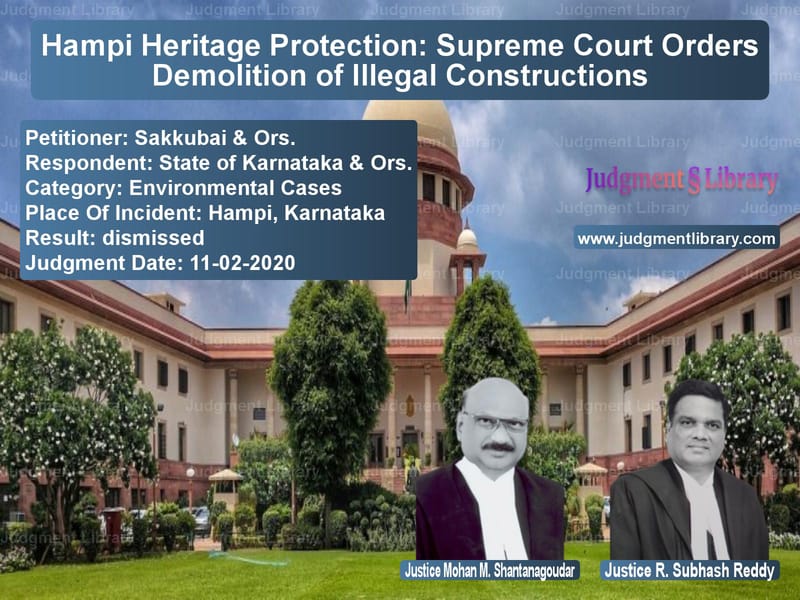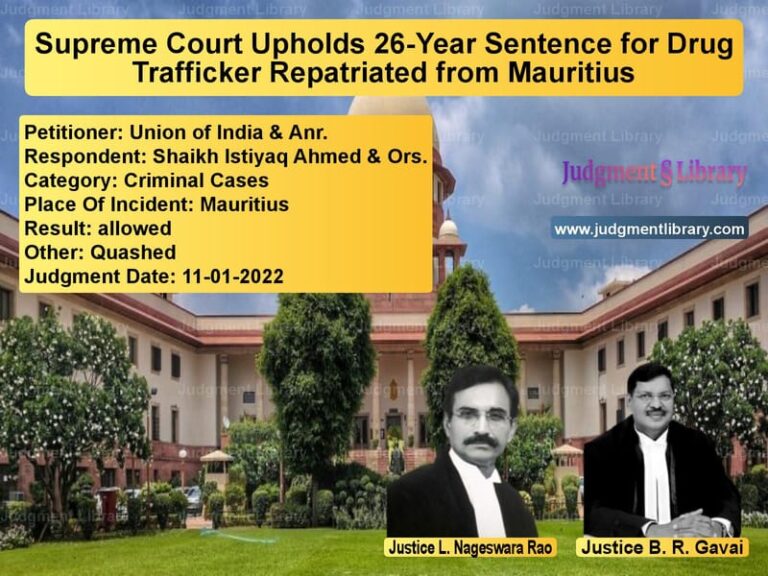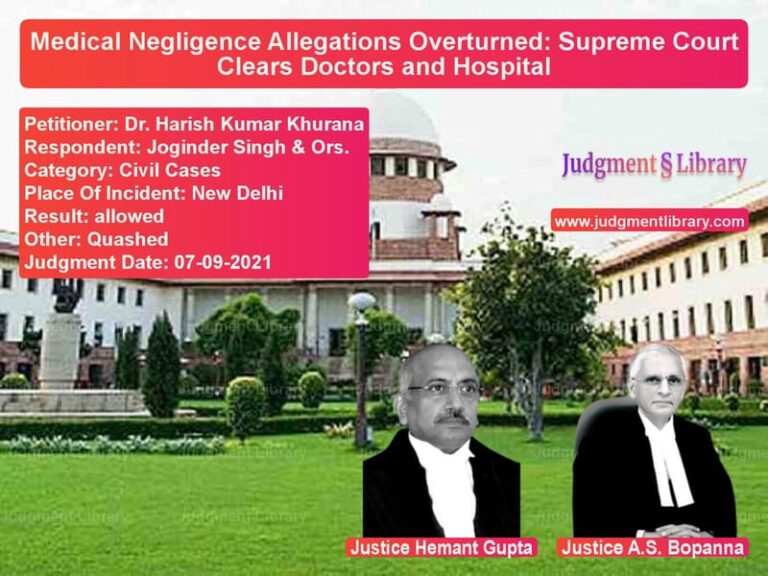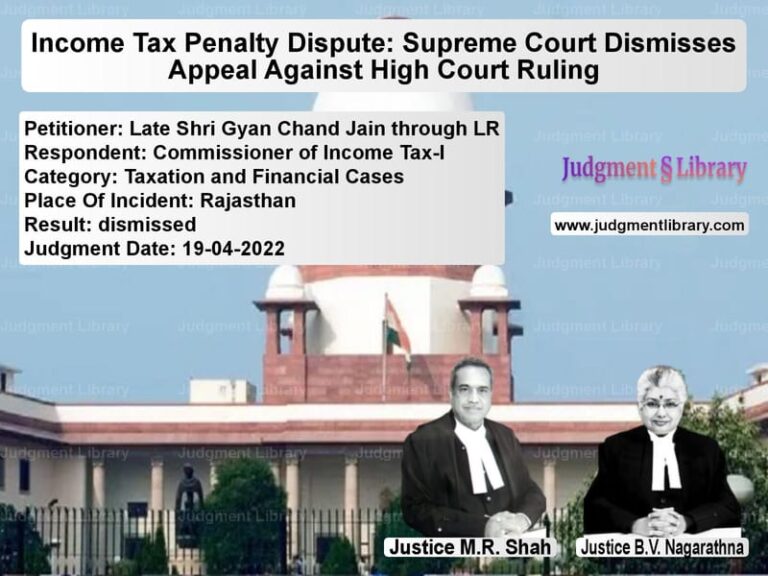Hampi Heritage Protection: Supreme Court Orders Demolition of Illegal Constructions
The case of Sakkubai & Ors. vs. State of Karnataka & Ors. is a landmark judgment concerning the preservation of historical sites and illegal constructions in the Hampi World Heritage Area. The Supreme Court upheld the Karnataka High Court’s decision ordering the demolition of hotels, restaurants, and guest houses built in the protected village of Virupapura Gaddi. This ruling reaffirmed the legal framework protecting heritage sites and clarified the jurisdiction of the Hampi World Heritage Area Management Authority (HWHAMA) over illegal structures.
Background of the Case
Virupapura Gaddi, an island on the Tungabhadra River, is located within the Hampi World Heritage Site, a region of immense historical and archaeological importance. The Karnataka government, under the Mysore Ancient and Historical Monuments and Archaeological Sites and Remains Act, 1961 (the 1961 Act), declared Virupapura Gaddi a ‘protected area’ through a notification in 1988.
Despite this, several individuals built commercial establishments, including hotels and guest houses, without proper approval. The introduction of the Hampi World Heritage Area Management Authority Act, 2002 (Hampi Act) led to stricter regulations, and the HWHAMA ordered the demolition of illegal structures. The affected parties filed writ petitions before the Karnataka High Court, challenging the demolition orders.
Arguments by the Petitioner
The appellants, primarily business owners in Virupapura Gaddi, argued the following:
- The entire village could not be declared a ‘protected area’ under Section 19 of the 1961 Act, as there were no specific archaeological remains within their land.
- Their businesses were legally operated after obtaining necessary licenses from local authorities, including the village panchayat.
- The HWHAMA lacked jurisdiction to demolish structures built before the enactment of the Hampi Act.
- The Hampi Act could not be applied retrospectively to existing structures.
- Since the validity of the 1988 notification was under challenge in a separate case before the Karnataka High Court, the demolition should be stayed.
Arguments by the Respondent
The State of Karnataka and the HWHAMA countered these claims, arguing:
- The 1988 notification explicitly included Virupapura Gaddi as a protected area, making all constructions within it subject to heritage conservation laws.
- The Archaeological Survey of India (ASI) had recognized the area’s historical significance, noting that Virupapura Gaddi contained ruins and relics linked to the Vijayanagara Empire.
- Under Section 20 of the 1961 Act, only agricultural use was permitted in a protected area without government approval.
- Licenses issued by local panchayats were unauthorized, as the authority to approve construction in protected areas rested solely with the state government.
- The HWHAMA had the power to enforce demolition under both the Hampi Act and the 1961 Act.
Supreme Court’s Key Observations
The Supreme Court extensively analyzed the legal provisions governing protected areas and heritage conservation. The key observations were:
- The declaration of Virupapura Gaddi as a protected area under the 1961 Act was valid and legally binding.
- Once an area is designated as protected, no construction can take place without express government approval.
- The concept of ‘archaeological sites and remains’ under the 1961 Act is broad enough to include areas of historical significance, even if no monuments exist on every plot of land.
- The Hampi Act did not introduce new restrictions but reinforced existing protections under the 1961 Act.
- The petitioners’ reliance on panchayat-issued licenses was misplaced, as these licenses were granted without legal authority.
Key Judicial Statements
The Supreme Court made several important judicial pronouncements, stating:
“The protection of heritage sites is of paramount importance. Commercial interests cannot override the statutory mandate for conservation.”
The Court further ruled:
“A declaration under the 1961 Act is conclusive evidence of an area’s protected status, and any subsequent construction in violation of this declaration is unlawful.”
Final Verdict
The Supreme Court dismissed the appeals and upheld the Karnataka High Court’s decision. The Court directed the immediate demolition of all unauthorized constructions in Virupapura Gaddi and reaffirmed the authority of the HWHAMA in enforcing heritage conservation laws.
Petitioner Name: Sakkubai & Ors..Respondent Name: State of Karnataka & Ors..Judgment By: Justice Mohan M. Shantanagoudar, Justice R. Subhash Reddy.Place Of Incident: Hampi, Karnataka.Judgment Date: 11-02-2020.
Don’t miss out on the full details! Download the complete judgment in PDF format below and gain valuable insights instantly!
Download Judgment: Sakkubai & Ors. vs State of Karnataka & Supreme Court of India Judgment Dated 11-02-2020.pdf
Direct Downlaod Judgment: Direct downlaod this Judgment
See all petitions in Environmental Cases
See all petitions in Property Disputes
See all petitions in Judgment by Mohan M. Shantanagoudar
See all petitions in Judgment by R. Subhash Reddy
See all petitions in dismissed
See all petitions in supreme court of India judgments February 2020
See all petitions in 2020 judgments
See all posts in Environmental Cases Category
See all allowed petitions in Environmental Cases Category
See all Dismissed petitions in Environmental Cases Category
See all partially allowed petitions in Environmental Cases Category







